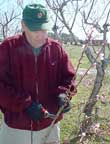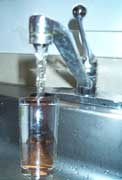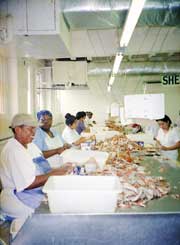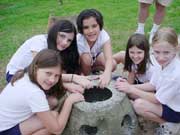|
|
 Turning Pruning into Profit Turning Pruning into Profit
Cast-off peach branches a business bonus
by Carrie Steele
The famous cherry blossoms of Washington, D.C., have withered and faded, yielding to other trees now making their spring debuts.
Their flowers called to Tony Evans on a chilly, bright morning last week as he ambled between rows of peach trees, sizing up branches strewn about Peggy and Bill Harris’ orchard floor. All of these straight, pruned branches, ripe with pink buds were destined for bonfire fuel.
Evans had a different idea.
Turning waste into dollars is how Annapolitan Evans — a retired farmer, journalist and Maryland Department of Agriculture staffer — gives new life to pruned orchard blossoms and adds one more link to the life of the orchard tree.
“I scavenge,” said Evans, 67, who sells his findings at the Anne Arundel Farmers market.
On this early April morning, Evans was collecting pruned branches of Jersey Queen peach trees. The branches range from about a foot and a half to about three feet long.
When Evans spots a likely candidate, he clips side branches from the main stem until the remaining dark chocolate-brown branch is as straight as a conductor’s baton, lined with magenta blossoms. These buds will bloom into quarter-sized, pink blossoms.
“Here’s a lovely concentration of tight buds,” Evans said, holding up a branch armed with buds. To keep the blossoms looking bright, Evans suggests taking them home and clipping off an inch or two of stem at a 90-degree angle before submerging the cut end in warm water.
Recovering Blossoms
Evans is a connoisseur of blossoms. Now he sells only peach blossoms, but he’d like to expand his variety of clippings.
“I’d love to get into crab apples,” Evans said. “I’d fertilize the devil out of them before they bloom.” He doesn’t bother with nectarine blossoms, whose smaller and paler petals don’t match up to the peach flowers he’s been selling.
“Ooh! Bonanzaville!” Evans said as he trimmed five cuttings stacked with peach buds off of just one branch. “I’m pretty good at grading them out in the orchard,” he added. He examines each cutting a second time before he stores them in his cold-room.
“See the cicada damage from last year?” Evans asked, pointing out a branch with a paperclip-sized grey scar. He tossed it aside as too imperfect for his collection.
In his second year of orchard blossom recovery, Evans works with Peggy and Bill Harris, who own a 50-acre farm just north of the Calvert and Anne Arundel line.
The Harrises grow 14 varieties of peaches, as well as several varieties of plums, apples and pears. Their peaches have brought home prizes at the state fair eight of the last 11 years, Peggy Harris said.
Working ahead of Evans, Harris and her two workers pruned her peach trees to allow sunlight to reach all the branches. Later, Evans explained, they’ll knock off some of the little peaches that begin forming, to concentrate the plants’ energy on a few good fruits.
“Trees naturally prune themselves, too,” said Evans. “They’ll drop hundreds of peaches themselves.”
After the rounds of pruning, each branch will have about two good peaches.
“If you have 14 peaches on a branch, they’d be so heavy the branches would snap off,” Evans said. “Pencil-thin branches bear the best fruit.”
The pruned branches are unwanted by both the tree and the Harrises. But the castoff growth is just what Evans seeks.
“I’m dumpster-diving,” Evans said. “All this would be raked up and burned, because branches left lying on the ground can harbor disease.”
The time is ripe for pruning, as the peach trees have been blooming.
March’s lower than normal temperatures had the trees budding very slowly. When warmer temperature and loads of sunlight arrived the first week of April, budding flourished.
“The weather was like an accelerator pedal,” said Evans, who predicts that peaches will start growing in one to two weeks. So he’s got to strike the moment his window of opportunity opens.
Turning Waste into Profits
After Evans gleans his crop of branches from the ground, he takes them to his cold-room, where blossoms thrive in buckets until they find homes with Evans’ customers.
“On Saturday I’ll take the ones that are really popping,” Evans said as he opened the door to the cold-room where he stores his cuttings at about 35 degrees.
“Last year I got mine to hold for five weeks,” said Evans, who sells orchard cuttings to two flower shops in Annapolis in addition to his sales at the farmers’ markets.
Farmers’ markets yield the freshest and most local produce and flowers you can buy, advises Evans, who helped found 34 farmers’ markets around the state.
“Your average produce travels about 1,500 miles. These peaches travel about 20 miles to the farmers’ market,” Evans said as he motioned to the peach orchard basking in the sun behind him. “Our customers are right here, right down the road. We make stuff our neighbors want to buy.”
Neighbors can find Evans and his blossoms at the Annapolis farmers market, where he’ll take 200 or 300 branch cuttings to sell each Saturday for the next two weeks.
As he sells, he keeps an ear open for bettering his business.
“I do consumer research with everyone who comes to my table,” Evans said. “Especially if I have repeat customers, I find out how long their blossoms lasted. Most customers tell me that their cuttings last seven to 10 days.”
 Full Circle Full Circle
Evans grew up on a farm in Bucks County, Pennsylvania. Now back on the farm, he feels like his life has come full circle. Dressed in cream-colored corduroys, white rubber boots, green cap and a maroon fleece, Evans keeps his pruning clippers in a leather holder in his back pocket on trips out to the orchard.
The grandfather of local farmers’ markets worked at the Department of Agriculture for 30 years. “I was the 11th person they hired,” he said, looking back. “When I left I was the longest serving employee in the department.”
Evans, who now has lived in Annapolis for 35 years, still calls himself a country boy.
“I’ve always had a real thing for agriculture,” he said. “It’s the most honest work you can find.”
As he walked down a row of trees, a startled brown-tailed hawk skimmed past the tops of nectarine trees. “One of the pleasures of being out here in the orchard,” Evans said, “is seeing the wildlife.”
Evans applies his agriculture know-how from his childhood farm days to lessons he’s still learning about his blossom-scavenging business.
“The whole idea came from Frank Gouin,” Evans said, his face lighting up as he mentions the environmental horticulturalist and University of Maryland professor emeritus whose gardening column appears exclusively in Bay Weekly. “Frank gave a talk at an Anne Arundel farmers meeting about three years ago, and a light bulb went off in my head.”
That bright idea now has Evans out in the spring orchard, enjoying the best working conditions nature has to offer.
top of page
 The Spring that Flows From Annapolis’ Taps The Spring that Flows From Annapolis’ Taps
Is city water good enough to bottle? Annapolis’ official Town Taster will tell
by Carrie Steele
Our state capital, Annapolis, takes particular pride in more than history, beautiful landscapes and gardens. The apple of Annapolis’ eye is water.
Its no wonder, with miles of coastline bordering creeks and inlets; two major rivers meeting the Bay; and boats abounding at the city’s public and private docks. There are also numerous city rain gardens slowing runoff to the wetlands and rivers that citizens take great care to maintain. Annapolis is a city built on water.
Annapolis’ own municipal water comes from seven wells 250 to 1,100 feet deep that tap into three aquifers: the Magothy, Upper Patapsco and Lower Patapsco. The wells feed the adjacent water plant off of Route 450, going through two treatments: iron removal and chlorination to prevent bacteria from growing.
Now Annapolis seeks an official Town Taster to vouch for the goodness of its drinking water.
The volunteer won’t be sampling gourmet Annapolis food and wine; instead, it’s everyday city tap water this honorary taster will sample.
The Town Taster will go to work at the Public Works Expo at Annapolis City Dock on May 18. Make that Tasters. Because of multiple applications, Public Works has empowered a small panel of three citizens to be the official Town Tasters. They are Richard Walker, Caryl Weiss and Debbie Perdue.
“One of the applicants had been in Annapolis for a long time, then moved away and had another city’s water and has been drinking spring water while he was out,” said Harry Sandrouni of Annapolis Public Works. Clearly, that other town’s water wasn’t worth drinking.
Stationed at the Water Treatment Pavilion, the Town Tasters will sample water from some 15 faucets from Eastport to West Annapolis. Samples of bottled spring water will be included for comparison’s sake.
“We’ll keep them the same temperature and same conditions, serve out of the same glass cups,” Sandrouni said.
Water tasting is akin to rating wines. According to Bottled Water Web’s webpage, water tasting should be approached in much the same way as wine tasting. First size up the water visually, checking for any color, cloudiness or suspended particles. Next, swirl the glass and smell for any odor, such as chlorine, plastic or mustiness. Finally, spread water through the mouth and evaluate for flavors of saltiness, iron, sulfur or staleness.
Such precision is a requirement at top water tasting competitions, such as the 2005 Berkeley Springs International Water Tasting, the largest water-tasting event in the country. There, Annapolis’ municipal water competed earlier this year against 32 other municipalities internationally. Top prizes went to British Columbia, Daytona Beach and New Zealand, as well as towns in Wisconsin, Virginia and California.
Now it’s Annapolis’ own who will judge the waters that flow from city taps.
No matter what the Town Tasters conclude, Annapolis takes great pride in its water — and its waterways.
“The message is why we’re doing this,” said Sandrouni. “Water is a valuable treasure.” We have to protect our water from the beginning, when it enters our water systems, Sandrouni continued, to the end, when it ends up in the Bay or in our tap.
“We’re going to have over 200 kids working in the tent,” said Sandrouni, who hopes the students understand how precious water is. “If you can get the younger generations to see the value of water, then you’ve planted a seed.”
How will Annapolis’s water from points across town hold up against each other, and bottled water?
We’ll let the Town Taster be the judge of that.
top of page
 Update: Will Crab be Picked in Maryland This Season? Update: Will Crab be Picked in Maryland This Season?
Mikulski gets a hit for Maryland seafood and seasonal businesses; victory hangs on more heavy hitting
by M.L. Faunce
On a cool April evening while both the Baltimore Orioles and the new Washington Nationals were playing baseball, Sen. Barbara Mikulski went to bat. The Baltimore native came out swinging on the floor of U.S. Senate “determined to get a vote” on an amendment to help save small and seasonal businesses. In Maryland, that meant relief for businesses that rely on migrant seasonal workers to pick crabs in summer and to shuck oysters in winter.
The amendment, tagged to a major emergency-spending bill to fund U.S. military operations in Iraq and Afghanistan, “is supported on both sides of the aisle,” Mikulski said.
The short senator from Maryland indeed got a big hit. Her amendment passed the Senate by a vote of 94-6.
But victory depends on more heavy hitting. The Iraq-Afghanistan Supplement Bill is now in conference committee, where Mikulski must get consensus if the Save Our Small and Seasonal Business Amendment is to move forward. It is opposed by the Republican leadership, which is trying to keep the $80.6 billion legislation free of more controversial immigration issues.
In conference committee, Mikulski will repeat her argument to senators. The real issue, she said, is the survival of small and seasonal businesses all over America.
“These businesses are in crisis,” the hard-hitting senator told Senate colleagues. “They need seasonal workers before the summer so that they can survive. For many years they have relied on the H2B Visa program to meet these needs, but this year they can’t get the temporary labor they need because … the cap [was] reached early in the year.”
The H2B Visa program allows temporary foreign workers to be hired for jobs for which no American workers are available. But only 66,000 H2B Visa workers are allowed per year. The cap for the current fiscal year, begun October 1, was met in January.
“In my own home state, this affects primarily the seafood industry,” Mikulski said. “They hire all the American workers they can find, but at this time of year they need additional help.”
Maryland businesses say they need about 7,700 workers.
Among the businesses in crisis is the J.M. Clayton Seafood Company of Cambridge, the oldest working crab processing plant in the world. Clayton Seafood supplements its regular, local workers with 65 H2B Visa guest workers.
“Maryland firms using H2B workers produce 92 percent of our state’s crabmeat,” said Clayton’s Jack Brooks.
In mid March, with the crab season about to open but no guest workers allowed in to do the picking, the Chesapeake Bay Seafood Industries Association declared a “state of emergency.”
That emergency is one more segment in the vicious circle of Bay degradation. Thus, too many people in Chesapeake Country … too few crabs and oysters … too little catch … a failing Bayfood industry … too few jobs … loss of job skill … too few pickers and shuckers in Chesapeake Country.
Mikulski’s bill is a temporary two-year fix that exempts returning seasonal workers from the cap, allowing businesses to survive while, she said, “comprehensive reform goes forward.”
It would not she said, open the gates to a flood of illegal immigrants. Instead, it would “keep the doors of American companies open while we also maintain control of our borders.”
You last read about this issue in Vol. XIII, No. 8, on February 24.
top of page
 |
| Fourth-graders (clockwise from left) Caitlin Anson, Noelle Sellars, Tori Carney, Veronica Pierce and Michaella Hoen-Saric created 150-pound molded concrete reef balls that will become safe homes for fish, crabs and other marine life. |
Hands on the Environment
On Gibson Island, Earth Day Was a School Day
(An occasional series of firsthand accounts of saving the Bay)
The sun beat against the white walls of Gibson Island Country School, which was unusually silent for Monday morning. The playground, cradled between the Gibson Island Harbor and the school’s nature trail, was still. The school pier stretched into the harbor, a stone’s throw from Chesapeake Bay.
Then the gymnasium doors opened with a flurry of activity. Some students headed to class, while others, armed with wheelbarrows, shovels and bags of concrete, made their way to the harbor side of the school. On April 18, these students were starting Bay Week, a celebration of the Bay and a lesson in stewardship, by making reef balls to help their local waters.
Reef balls are a new life form in oceans around the world. They come in all sizes — some as large as 6,000 pounds — and look like a mound of rock riddled with large holes. Gibson Island Country School students poured concrete into a hemispheric fiberglass mold. Holes were then perforated through the mold using an air compressor and different sized rubber balls. Their reef balls — weighing 150 pounds and standing two and a half feet high by three feet wide — will be the first shallow-water reef ball experiment in Maryland.
Unmolded after 24 hours, the reef balls cure for 30 days. In June, they will be lowered beneath the school pier. The holes become a safe home for fish, crabs and other marine life. The ball’s surface is colonized by such marine organisms as mussels and oysters, whose filtering processes are a big plus for our Bay waters.
Gibson Island Country School project will be the first shallow-water reef-ball experiment in Maryland. The balls made by the students weigh 150 pounds and stand two and a half feet high by three feet wide. In June, they will be lowered under the school pier. By fishing above them and taking photos, students working with the Maryland Saltwater Fishermen’s Association will monitor the marine life attracted to their reef balls.
Students are looking forward to being a part of this. “It’s important because fish are dying,” said third-grader Ryan Cahouet. “It’s sad for the little fish. The big fish won’t be able to get inside the reef balls, so the little fish will be saved.”
Bay Week, which stretched from April 18 to Earth Day, April 22, builds on a long tradition of environmental learning and awareness that includes numerous projects such as growing native grasses to be planted in local tributaries of the Bay, growing oysters from spat to revive local oyster reefs and monitoring Bay water quality and turbidity.
Other Bay Week activities included live fish exploration, assembling safe nesting places for wood duck boxes and touring Gibson Island Harbor. Experts visited the school to talk about reef balls, sharks, nautical life and waterfowl.
“Bay Week was a wonderful opportunity to teach children about stewardship by getting them excited about the richness and diversity of the Bay and thus giving them a reason to accept responsibility of its future,” said science teacher Courtney Leigh, who plans to make Bay Week an annual event.
Fourth grader Tori Carney agreed that Bay Week “was a wonderful, interesting and fishy week of fun.”
|



 Turning Pruning into Profit
Turning Pruning into Profit Full Circle
Full Circle The Spring that Flows From Annapolis’ Taps
The Spring that Flows From Annapolis’ Taps
